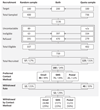Right Here Right Now (RHRN) pilot study: testing a method of near-real-time data collection on the social determinants of health
- PMID: 29973958
- PMCID: PMC6027954
- DOI: 10.1332/174426417X14987303892451
Right Here Right Now (RHRN) pilot study: testing a method of near-real-time data collection on the social determinants of health
Abstract
Background: Informing policy and practice with up-to-date evidence on the social determinants of health is an ongoing challenge. One limitation of traditional approaches is the time-lag between identification of a policy or practice need and availability of results. The Right Here Right Now (RHRN) study piloted a near-real-time data-collection process to investigate whether this gap could be bridged.
Methods: A website was developed to facilitate the issue of questions, data capture and presentation of findings. Respondents were recruited using two distinct methods - a clustered random probability sample, and a quota sample from street stalls. Weekly four-part questions were issued by email, Short Messaging Service (SMS or text) or post. Quantitative data were descriptively summarised, qualitative data thematically analysed, and a summary report circulated two weeks after each question was issued. The pilot spanned 26 weeks.
Results: It proved possible to recruit and retain a panel of respondents providing quantitative and qualitative data on a range of issues. The samples were subject to similar recruitment and response biases as more traditional data-collection approaches. Participants valued the potential to influence change, and stakeholders were enthusiastic about the findings generated, despite reservations about the lack of sample representativeness. Stakeholders acknowledged that decision-making processes are not flexible enough to respond to weekly evidence.
Conclusion: RHRN produced a process for collecting near-real-time data for policy-relevant topics, although obtaining and maintaining representative samples was problematic. Adaptations were identified to inform a more sustainable model of near-real-time data collection and dissemination in the future.
Keywords: evidence; policy; real-time; technology.
Conflict of interest statement
Competing interests The authors have no competing interests to declare.
Figures
Similar articles
-
Folic acid supplementation and malaria susceptibility and severity among people taking antifolate antimalarial drugs in endemic areas.Cochrane Database Syst Rev. 2022 Feb 1;2(2022):CD014217. doi: 10.1002/14651858.CD014217. Cochrane Database Syst Rev. 2022. PMID: 36321557 Free PMC article.
-
Qualitative Study.2022 Sep 18. In: StatPearls [Internet]. Treasure Island (FL): StatPearls Publishing; 2025 Jan–. 2022 Sep 18. In: StatPearls [Internet]. Treasure Island (FL): StatPearls Publishing; 2025 Jan–. PMID: 29262162 Free Books & Documents.
-
Pilot Medical Certification.2023 Feb 6. In: StatPearls [Internet]. Treasure Island (FL): StatPearls Publishing; 2025 Jan–. 2023 Feb 6. In: StatPearls [Internet]. Treasure Island (FL): StatPearls Publishing; 2025 Jan–. PMID: 33620822 Free Books & Documents.
-
[Standard technical specifications for methacholine chloride (Methacholine) bronchial challenge test (2023)].Zhonghua Jie He He Hu Xi Za Zhi. 2024 Feb 12;47(2):101-119. doi: 10.3760/cma.j.cn112147-20231019-00247. Zhonghua Jie He He Hu Xi Za Zhi. 2024. PMID: 38309959 Chinese.
-
Digital First Primary Care for those with multiple long-term conditions: a rapid review of the views of stakeholders.Health Soc Care Deliv Res. 2024 Jul;12(21):1-68. doi: 10.3310/AWBT4827. Health Soc Care Deliv Res. 2024. PMID: 39056123 Review.
Cited by
-
Just Google it: Measuring schools' use of research evidence with internet search results.Evid Policy. 2019 Jan;15(1):103-123. doi: 10.1332/174426418X15172392413087. Evid Policy. 2019. PMID: 31073322 Free PMC article.
-
An Approach to Dynamic Sensing Data Fusion.Sensors (Basel). 2019 Aug 23;19(17):3668. doi: 10.3390/s19173668. Sensors (Basel). 2019. PMID: 31450794 Free PMC article.
References
-
- Barr B, Bambra C, Smith K. For the good of the cause: generating evidence to inform social policies that reduce health inequalities. In: Smith KE, Bambra C, Hill SE, editors. Health Inequalities: Critical perspectives. Oxford: Oxford University Press; 2015. pp. 252–64.
-
- Brownson RC, Fielding JE, Maylahn CM. Evidence-based public health: A fundamental concept for public health practice. Annual Review of Public Health. 2009;30:175–201. - PubMed
-
- Bryman A. Social research methods. 3rd edn. NewYork: Oxford University Press; 2008.
-
- Caron-Flinterman JF, Broerse JEW, Bunders JFG. The experiential knowledge of patients: A new resource for biomedical research? Social Science & Medicine. 2005;60(11):2575–84. - PubMed
Grants and funding
LinkOut - more resources
Full Text Sources
Other Literature Sources
Miscellaneous


